实验五
ex2-1-1
// 练习:使用二分查找,在一组有序元素中查找数据项 // 形参是数组,实参是数组名 #include <stdio.h> #include <stdlib.h> const int N=5; int binarySearch(int x[], int n, int item); // 函数声明 int main() { int a[N]={2,7,19,45,66}; int i,index, key; printf("数组a中的数据:\n"); for(i=0;i<N;i++) printf("%d ",a[i]); printf("\n"); printf("输入待查找的数据项: "); scanf("%d", &key); // 调用函数binarySearch()在数组a中查找指定数据项item,并返回查找结果给index // 补足代码① index=binarySearch(a,N,key); if(index>=0) printf("%d在数组中,下标为%d\n", key, index); else printf("%d不在数组中\n", key); system("pause"); return 0; } //函数功能描述: //使用二分查找算法在数组x中查找特定值item,数组x大小为n // 如果找到,返回其下标 // 如果没找到,返回-1 int binarySearch(int x[], int n, int item) { int low, high, mid; low = 0; high = n-1; while(low <= high) { mid = (low+high)/2; if (item == x[mid]) return mid; else if(item<x[mid]) high = mid - 1; else low = mid + 1; } return -1; }

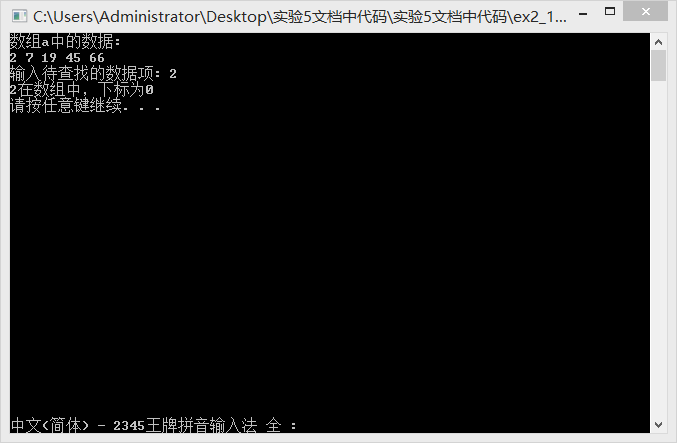
ex2-1-2
/* N个字典序的整数已放在一维数组中,给定下列程序中,函数fun的功能是: 利用折半查找算法查找整数m在数组中的位置。 若找到,则返回其下标值;反之,则返回-1 */ #include <stdio.h> #include <stdlib.h> #define N 10 int fun(int *a,int m) { int low = 0, high = N-1, mid; /*************ERROR**************/ while(low<=high) { mid = (low+high)/2; /*************ERROR**************/ if(m < *(a+mid)) high = mid-1; /*************ERROR**************/ else if(m > *(a+mid)) low = mid+1; else return(mid); } return(-1); } int main() { int i,a[N]={-3,4,7,9,13,24,67,89,100,180},k,m; printf("a数组中的数据如下:\n"); for(i=0;i<N;i++) printf("%d ",a[i]); printf("\nEnter m: \n"); scanf("%d",&m); /*************ERROR**************/ k = fun(a,m); if (k>=0) printf("m=%d,index=%d\n",m,k); else printf("Not be found!\n"); system("pause"); return 0; }
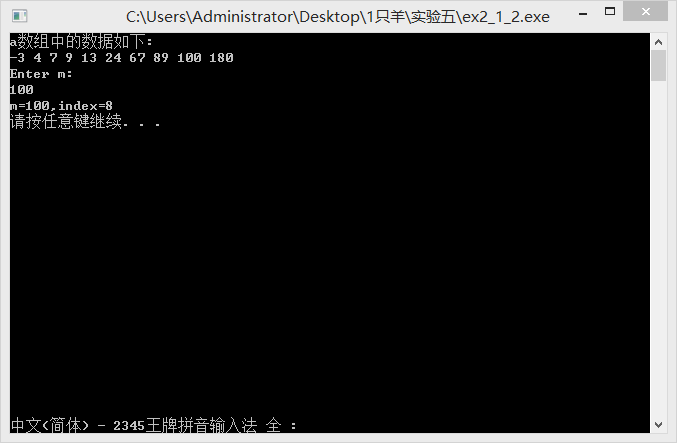
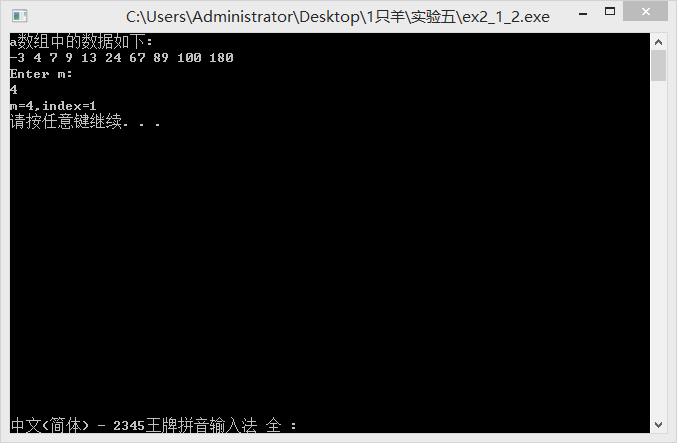
ex2-2-2
// 练习:使用选择法对字符串按字典序排序 #include <stdio.h> #include <string.h> #include <stdlib.h> void selectSort(char str[][20], int n ); // 函数声明,形参str是二维数组名 int main() { char name[][20] = {"John", "Alex", "Joseph", "Taylor", "George"}; int i; printf("输出初始名单:\n"); for(i=0; i<5; i++) printf("%s\n", name[i]); selectSort(name, 5); // 调用选择法对name数组中的字符串排序 printf("按字典序输出名单:\n"); for(i=0; i<5; i++) printf("%s\n", name[i]); system("pause"); return 0; } // 函数定义 // 函数功能描述:使用选择法对二维数组str中的n个字符串按字典序排序 void selectSort(char str[][20], int n) { // 补足代码 int i,j,p; char temp[20]; for(i=0;i<n-1;i++) { p=i; for(j=i+1;j<n;j++) { if(strcmp(str[p],str[j])>0) p=j; } if(p!=i) { strcpy(temp,str[i]); strcpy(str[i],str[p]); strcpy(str[p],temp); } } }
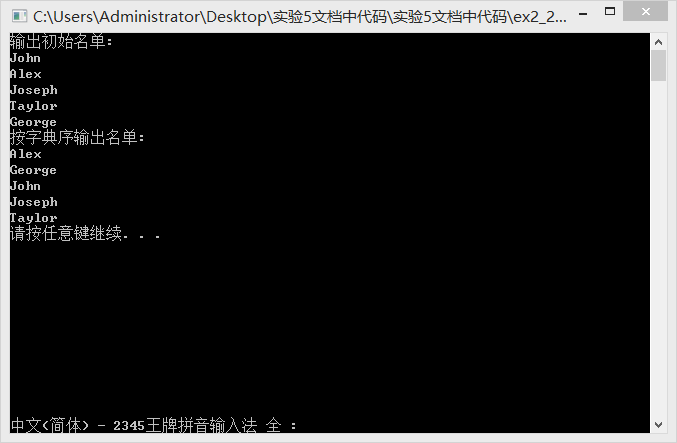
ex2-3-1
/* 假定输入的字符串中只包含字母和*号。 编写函数,实现: 除了字符串前导的*号之外,将串中其他*号全部删除。 在编写函数时,不得使用C语言提供的字符串函数。 例如,若字符串中的内容为****A*BC*DEF*G******* 删除后,字符串中的内容则应当是****ABCDEFG */ #include <string.h> #include <stdio.h> #include <stdlib.h> void fun(char *a) { /*****ERROR********/ int i=0; char *p = a; /****ERROR***/ while(*p &&*p == '*') { a[i] = *p; i++; p++; } while(*p) { /******ERROR*******/ if(*p != '*') { a[i] = *p; i++; } p++; } /******ERROR*******/ a[i] = 0; } int main() { char s[81]; printf("Enter a string :\n"); gets(s); /***ERROR******/ fun(s); printf("The string after deleted:\n"); puts(s); system("pause"); return 0; }
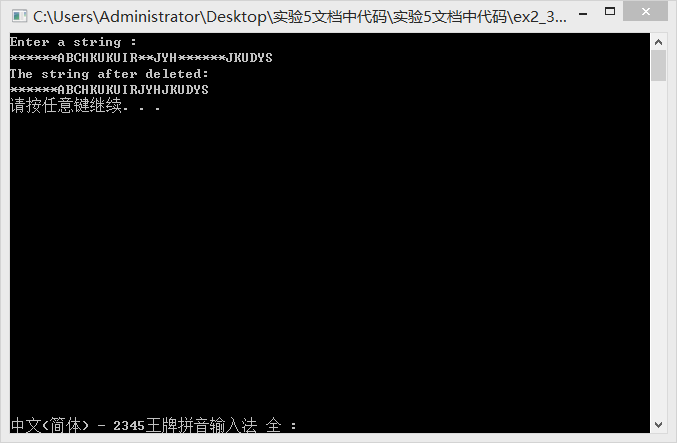
ex2-3-2
/* 假定输入的字符串中只包含字母和*号。 编写函数,实现: 除了字符串前导和尾部的*号之外,将串中其他*号全部删除。 在编写函数时,不得使用C语言提供的字符串函数。 例如,若字符串中的内容为****A*BC*DEF*G******* 删除后,字符串中的内容则应当是****ABCDEFG****** */ #include <stdio.h> #include <stdlib.h> #include <string.h> void fun(char *a) { /**ERROR******/ int i=0; char *t = a, *f = a; char *q = a; while(*t) t++; t--; while(*t == '*') t--; while(*f == '*') f++; /***ERROR***/ while (q<f) { a[i] = *q; q++; i++; } while (q<t) { /***ERROR**/ if(*q != '*') { a[i] = *q; i++; } q++; } while (*q) { a[i] = *q; i++; q++; } /**ERROR**/ a[i]=0; } int main () { char s[81]; printf("Entre a string:\n"); gets(s); /**ERROR**/ fun(s); printf("The sting after deleted:\n"); puts(s); system("pause"); return 0; }




 浙公网安备 33010602011771号
浙公网安备 33010602011771号